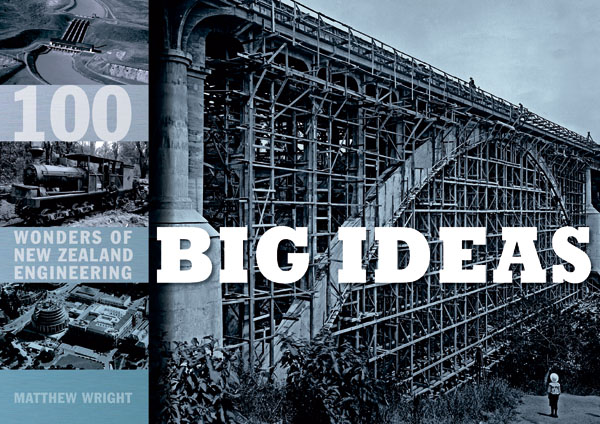Big Ideas: 100 Wonders of New Zealand Engineering
Big Ideas: 100 Wonders of New Zealand Engineering
Matthew Wright
2009, Random House ISBN 781869791070
The Blurb
Roads, bridges, dams, railway viaducts, tunnels . . . New Zealand is full of amazing feats of engineering. Our number-eight wire mentality has brought about some incredible engineering solutions to create structures and systems to wonder at, from the Manapouri underground power station to Burt Munro's famous Indian motorcycle. Who designed these amazing things? How were they built? What innovative solutions did their engineers use to overcome problems of terrain, weather, materials and cost?
From early Maori and European settlement through the boom days of the late 1900s into the Depression-era projects of the early twentieth century and on to the Think Big years, Wonders of New Zealand Engineering features 100 projects from around the country with informative text, fact boxes and historic photographs. This is a great book to dip into or read from cover to cover, showing the development of New Zealand's fascinating engineering heritage.
Mini Review
This is a POP page.
It represents a Personal OPinion.
That opinion is the sole responsiblity of the author and not the website!
Wright here returns to a theme he has published on before[1] - but this book has a wider compass. Some of the 100 feats featured are individual works and others are classes of engineering. Generally a two pages are dedicated to each of the selected wonders but occasionally this expands to three or four pages - not entirely rationally - surely Napier harbour works did not merit twice the space of those of Tauranga harbour? Wright is a professional historian rather than an engineer. He has not the detailed technical background to cover this wide field, but then who has? Generally though he does well in covering the technical side of the stories.
The inclusion of Maori military engineering is welcome. In the past it was not accepted as engineering at all by Pakeha engineers. Wright is a protagonist on views of Maori military engineering and this gets in the way here. Most readers need a more straight-forward account and will not pick up some of what he is talking about.
The illustrations are all black and white, a mixture of modern and historical views - as one would expect. They are well chosen and credited.
Of course the selection of the 100 can be argued with - this reviewer would have liked to see fewer railway engines and perhaps at least one swapped for kauri dam engineering. Perhaps the Auckland to Wellington telegraph could have represented communications engineering that is otherwise missing.
The designers and builders of individual works are properly credited. Some surprises here - who would have thought the Wellington Railway Station had an input from Japanese engineers to overcome its difficult foundations?
An archaeologist would welcome a note or two more on which of the sites that are visitable - many are, but a reader new to the subject would not know.
An editing grizzle - all the 'words' pages have a box for key statistics but it is not always used and sometimes left with a only a few words and a lot of white space. In a publication where clearly there was pressure on the size of the text this is a wasted opportunity. Oh, and a check with an archaeologist on Maungakiekie might have fixed some misstatements.
Overall a book that lives up to the title - there are some real wonders in here and the span of this contribution is a welcome addition to the literature of our industrial archaeology.
References
- ↑ Matthew Wright 1999 Engineering Heritage 1870-2000 Reed
